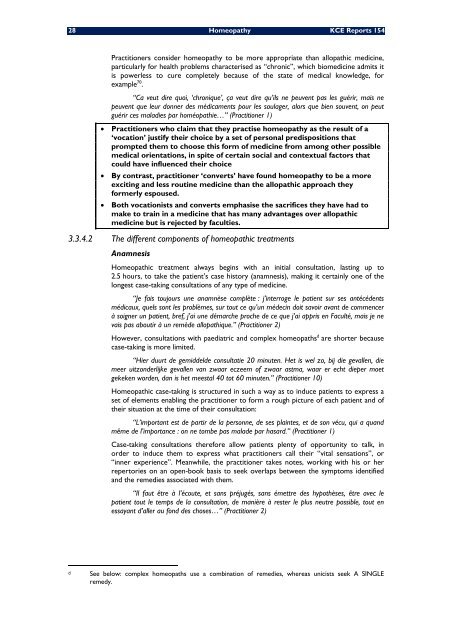Etat des lieux de l'homéopathie en Belgique - KCE
Etat des lieux de l'homéopathie en Belgique - KCE
Etat des lieux de l'homéopathie en Belgique - KCE
Create successful ePaper yourself
Turn your PDF publications into a flip-book with our unique Google optimized e-Paper software.
28 Homeopathy <strong>KCE</strong> Reports 154<br />
Practitioners consi<strong>de</strong>r homeopathy to be more appropriate than allopathic medicine,<br />
particularly for health problems characterised as “chronic”, which biomedicine admits it<br />
is powerless to cure completely because of the state of medical knowledge, for<br />
example 70 .<br />
“Ca veut dire quoi, ‘chronique’, ça veut dire qu’ils ne peuv<strong>en</strong>t pas les guérir, mais ne<br />
peuv<strong>en</strong>t que leur donner <strong><strong>de</strong>s</strong> médicam<strong>en</strong>ts pour les soulager, alors que bi<strong>en</strong> souv<strong>en</strong>t, on peut<br />
guérir ces maladies par homéopathie…” (Practitioner 1)<br />
• Practitioners who claim that they practise homeopathy as the result of a<br />
‘vocation’ justify their choice by a set of personal predispositions that<br />
prompted them to choose this form of medicine from among other possible<br />
medical ori<strong>en</strong>tations, in spite of certain social and contextual factors that<br />
could have influ<strong>en</strong>ced their choice<br />
• By contrast, practitioner ‘converts’ have found homeopathy to be a more<br />
exciting and less routine medicine than the allopathic approach they<br />
formerly espoused.<br />
• Both vocationists and converts emphasise the sacrifices they have had to<br />
make to train in a medicine that has many advantages over allopathic<br />
medicine but is rejected by faculties.<br />
3.3.4.2 The differ<strong>en</strong>t compon<strong>en</strong>ts of homeopathic treatm<strong>en</strong>ts<br />
Anamnesis<br />
Homeopathic treatm<strong>en</strong>t always begins with an initial consultation, lasting up to<br />
2.5 hours, to take the pati<strong>en</strong>t’s case history (anamnesis), making it certainly one of the<br />
longest case-taking consultations of any type of medicine.<br />
“Je fais toujours une anamnèse complète : j’interroge le pati<strong>en</strong>t sur ses antécé<strong>de</strong>nts<br />
médicaux, quels sont les problèmes, sur tout ce qu’un mé<strong>de</strong>cin doit savoir avant <strong>de</strong> comm<strong>en</strong>cer<br />
à soigner un pati<strong>en</strong>t, bref, j’ai une démarche proche <strong>de</strong> ce que j’ai appris <strong>en</strong> Faculté, mais je ne<br />
vais pas aboutir à un remè<strong>de</strong> allopathique.” (Practitioner 2)<br />
However, consultations with paediatric and complex homeopaths d are shorter because<br />
case-taking is more limited.<br />
“Hier duurt <strong>de</strong> gemid<strong>de</strong>l<strong>de</strong> consultatie 20 minut<strong>en</strong>. Het is wel zo, bij die gevall<strong>en</strong>, die<br />
meer uitzon<strong>de</strong>rlijke gevall<strong>en</strong> van zwaar eczeem of zwaar astma, waar er echt dieper moet<br />
gekek<strong>en</strong> wor<strong>de</strong>n, dan is het meestal 40 tot 60 minut<strong>en</strong>.” (Practitioner 10)<br />
Homeopathic case-taking is structured in such a way as to induce pati<strong>en</strong>ts to express a<br />
set of elem<strong>en</strong>ts <strong>en</strong>abling the practitioner to form a rough picture of each pati<strong>en</strong>t and of<br />
their situation at the time of their consultation:<br />
“L’important est <strong>de</strong> partir <strong>de</strong> la personne, <strong>de</strong> ses plaintes, et <strong>de</strong> son vécu, qui a quand<br />
même <strong>de</strong> l’importance : on ne tombe pas mala<strong>de</strong> par hasard.” (Practitioner 1)<br />
Case-taking consultations therefore allow pati<strong>en</strong>ts pl<strong>en</strong>ty of opportunity to talk, in<br />
or<strong>de</strong>r to induce them to express what practitioners call their “vital s<strong>en</strong>sations”, or<br />
“inner experi<strong>en</strong>ce”. Meanwhile, the practitioner takes notes, working with his or her<br />
repertories on an op<strong>en</strong>-book basis to seek overlaps betwe<strong>en</strong> the symptoms i<strong>de</strong>ntified<br />
and the remedies associated with them.<br />
“Il faut être à l’écoute, et sans préjugés, sans émettre <strong><strong>de</strong>s</strong> hypothèses, être avec le<br />
pati<strong>en</strong>t tout le temps <strong>de</strong> la consultation, <strong>de</strong> manière à rester le plus neutre possible, tout <strong>en</strong><br />
essayant d’aller au fond <strong><strong>de</strong>s</strong> choses…” (Practitioner 2)<br />
d See below: complex homeopaths use a combination of remedies, whereas unicists seek A SINGLE<br />
remedy.

















